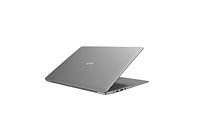Friday, December 13th 2019

LG Announces new Gram Laptop Lineup Powered by Intel Ice Lake CPUs
LG Electronics' newest gram laptop computer series - the LG gram 17 (model 17Z90N), LG gram 15 (model 15Z90N), LG gram 14 (model 14Z90N) and 14-inch LG gram 2-in-1 (model 14T90N) - is designed to set a new standard for portable computing and will satisfy the needs of the most demanding users. The 2020 lineup of LG gram laptops stick to the company's winning formula - lightweight, compact, long battery life - while adding even more performance.
At the heart of the new series is the 10th Generation Intel Core processor with Iris Plus graphics and up to 24 GB of dual-channel DDR4 memory. With double the graphics processing power of last year's models, content creators will love having the speed and power to edit 4K video on-the-go and users will marvel at how smooth games can be with Iris Plus built-in.With a larger 80Wh battery in both the 17Z90N and 15Z90N, users can still enjoy hours and hours of use away from an outlet with no sacrifice in portability. The new LG grams also come with Wi-Fi 6 ensuring enhanced wireless connectivity, better efficiency and lower battery consumption. The new LG grams feature Mega Cooling System to keep the devices running cool and quiet under all usage scenarios.
A CES 2020 Innovation Award winner, the flagship LG gram 17 is the ultimate solution for anyone looking for maximum productivity in a portable form factor. The expansive 17-inch Wide Quad Extended Graphics Array (WQXGA) IPS display delivers highly detailed images with incredibly precise colors. The device's 16:10 display provides more room to work when editing videos, photos and documents.
Redesigned for 2020, the new lineup delivers more features and a minimalist design for a seamless, premium look. The new LG gram 15 and LG gram 14 continue the brand's legacy of providing long usage times for less charging and more convenience. LG's svelte laptops are industry benchmarks in its ability to fit a 15-inch display in a 14-inch body and a 14-inch screen in a chassis designed for a 13.3-inch computer.
LG's ultra-portable convertible laptop, the LG gram 2-in-1 (model 14T90N), returns this year with greater functionality and the addition of Thunderbolt 3. Giving users the power to be more productive no matter where they are, this versatile device retains its core DNA, delivering more than 20 hours of worktime in a package that tips the scale at only 1,145 grams.
"The LG gram series continues to lead the industry in delivering beyond expectations when it comes to portability without sacrifice," said Jang Ik-hwan, head of LG's IT business division. "Historically, customers had to choose one feature among performance, portability and battery life. LG gram is proof that this adage is no longer true."
Specifications:
At the heart of the new series is the 10th Generation Intel Core processor with Iris Plus graphics and up to 24 GB of dual-channel DDR4 memory. With double the graphics processing power of last year's models, content creators will love having the speed and power to edit 4K video on-the-go and users will marvel at how smooth games can be with Iris Plus built-in.With a larger 80Wh battery in both the 17Z90N and 15Z90N, users can still enjoy hours and hours of use away from an outlet with no sacrifice in portability. The new LG grams also come with Wi-Fi 6 ensuring enhanced wireless connectivity, better efficiency and lower battery consumption. The new LG grams feature Mega Cooling System to keep the devices running cool and quiet under all usage scenarios.
A CES 2020 Innovation Award winner, the flagship LG gram 17 is the ultimate solution for anyone looking for maximum productivity in a portable form factor. The expansive 17-inch Wide Quad Extended Graphics Array (WQXGA) IPS display delivers highly detailed images with incredibly precise colors. The device's 16:10 display provides more room to work when editing videos, photos and documents.
Redesigned for 2020, the new lineup delivers more features and a minimalist design for a seamless, premium look. The new LG gram 15 and LG gram 14 continue the brand's legacy of providing long usage times for less charging and more convenience. LG's svelte laptops are industry benchmarks in its ability to fit a 15-inch display in a 14-inch body and a 14-inch screen in a chassis designed for a 13.3-inch computer.
LG's ultra-portable convertible laptop, the LG gram 2-in-1 (model 14T90N), returns this year with greater functionality and the addition of Thunderbolt 3. Giving users the power to be more productive no matter where they are, this versatile device retains its core DNA, delivering more than 20 hours of worktime in a package that tips the scale at only 1,145 grams.
"The LG gram series continues to lead the industry in delivering beyond expectations when it comes to portability without sacrifice," said Jang Ik-hwan, head of LG's IT business division. "Historically, customers had to choose one feature among performance, portability and battery life. LG gram is proof that this adage is no longer true."
Specifications:







18 Comments on LG Announces new Gram Laptop Lineup Powered by Intel Ice Lake CPUs
I didnt know they made 12GB sticks now
Soldiering RAM - K.O.
works like a (anutha) lappy...
smells like a (anutha) lappy....
Guess what, it probably IS a (anutha) lappy.....
Sorry, but even with the new cpu's/batteries/wifi-6, I just don't see anything that's actually new here, at least nuthin that would make me wanna run out & buy these....
in other words: y/A/w/N///////
They could have limited these laptops to 16 GB (like a lot of competition does). Instead they let you add another 8GB. That extra 8GB will be slower, but the user shouldn't be bothered when it turns out 16 GB aren't enought.
Ryzen 3700U can do amazing things in a 15W TDP.
At 25W not only does it match Iris Plus in GPU performance, it does so with better driver compatibility and lower power usage.
It's a laptop: a tool, an everyday convenience. It's not an enthusiast gadget.
Ordinary people don't replace a laptop just because something newer came out. You confuse them with Apple or Ryzen owners. :)
They replace it when it breaks down, becomes unresponsive in everyday use or incompatible with other stuff they have.You don't like it or it doesn't work for your needs - don't buy it.
Most people are perfectly happy, because short boosts between long periods of low load is exactly how most PCs are used.Ryzen 3700U was shown to be slower and less efficient than Intel -U counterparts.
But more importantly, Ryzen's are power-hungry in idle, which is the main reason why we don't see too many ultrabooks using them.
As for 3700U, it may not be as efficient as 9th and 10th gen Intel in CPU-only tests, but that Iris Plus IGP is hungry, man. Real hungry.
I'm not sure where you got these numbers from.
There are Intel-based laptops that pull well under 5W total (in idle).
Ryzen figures are ~2-3W higher in comparable machines. And this makes a huge difference, because suddenly one laptop will be "up to 16h" and the other one just "up to 11h".
Also, it seems Intel's boosts during an occasional user action are shorter (it's a simpler architecture after all), so the actual gap in "real world" gets a bit wider.
Under load they become quite similar. But keeping a laptop under consistent high load is a fairly rare use case for an ultrabook.
Also, while these larger models have decent 80Wh, most laptops and 13-14" ultrabooks come with smaller batteries (~50Wh).Nope. It's just as frugal as every other Intel HD of late.
It's just a lot faster, so it will consume more when pushed to the limit (obviously).
The previous gen disabled virtualization, and no, they did not allow virtualization to be enabled through the BIOS. Has LG changed it's way in 2019? I doubt it.
Also, the Gram should support up to 40GB (32+8) of RAM. The 32GB SODIMMs do work with 10th Gen Intel CPUs.
Intel does a great job of retaining dual channel performance with RAM mistmatched in size. I wouldn't worry about this much.
Its always and always will be a compromise machine.You speak a lot of sense, but the last part... the reason isn't a few W in idle. The reason is established contracts that Intel has and AMD is lacking - note for example the recent Dell announcement as they stated looking at Ryzen cpus. Don't overestimate the importance of a tiny idle power gap. It never stopped us before, and you barely notice long standby time because you're not using it. Users 'feel' battery drain when they actually use it, as they will be looking at the % left as they do. Standby matters up to the point of being able to survive a full work day. A bit like phones do - very few people buy or don't buy a phone because of a few hours gap of standby in battery life.This is my experience too, when I actually have to do serious work, I make sure the thing is hooked up to power. For the regular day to day though, which is full of meetings and presentations and walking around with it, ultrabooks do fine. Its just not a productivity machine, really. Its also a thing of getting used to, but the whole machine feels like it has higher latency, its just not as snappy, though a big part of that is probably VPN, network and lots of cloud; but even when I have to load up large files *in Word locally* it all turns to shit, fast.
If you're actively using a laptop those "idle" figures are utterly meaningless. In the real world, if I stop using my machine for 3 minutes, the screen turns off, and if I don't wake it up in another two minutes the laptop goes to sleep, meaning that "idle" usage is almost never relevant. It's either "in use" or suspended/hibernated. If I truly wanted the most frugal CPU for light work, I'd be accepting the godawful performance of a fanless Intel Y-series chip anyway.At 25W, Intel claims their latest Iris Plus is comparable to Vega10. The problem is that Vega 10 and Vega 8 actually end up in 15W laptops more often than not and benchmarks of Vega8 and Vega10 at 15W don't make Iris Plus (64EU) look that great. This might be a driver thing, but so many games just don't run well at all on Iris Plus if you look at www.notebookcheck.net/Intel-Iris-Plus-Graphics-G7-Ice-Lake-64-EU-Laptop-GPU.422866.0.html. Still, it's going to be one Iris Plus sample against a huge range of AMD laptops reviewed, so take that with a pinch of salt.
Also, with Intel's horrible yields at 10nm, I would expect that real-world availability of the 64EU Iris Plus to be exceedingly rare and at eye-watering prices, all whilst sub-$1000 ultraportables with Ryzen 3500U and 3700U are available with mature drivers from almost every vendor. Kind of off-topic, but I just picked up an alloy-chassis Lenovo S540 3500U for a family member for £499 from Amazon, including 20% tax. You're not going to see LG Grams with Iris Plus for less than $1500, is my guess. Possibly over $2000 as it'll likely be locked to the very highest-spec options list.
Our laptops have 16GB and it wasn't even close enough. Now we work on VMs with 32GB, but an upgrade to 64GB is expected next year.
This class of laptops is also popular among scientists, engineers. Not everyone needs a workstation laptop. Not everyone wants to carry it.
Thin laptops like Dell XPS or Macbook Pro are available with 32GB RAM and it's not an overkill. As we get more dense memory, they will be available with 64GB for sure.I don't know what "actively" means. I click-a-lot?
Clicking a lot or writing won't push the CPU over few %. That's still in the "idle" range on a balanced power profile.If someone is happy with a S540 - I'm perfectly fine with that. But your argument is completely bonkers.
LG Gram competes with high-end ultrabooks, not cheap home laptops. It's expensive not because of the 10nm SoC, but because it's positioned for an expensive segment.
Ice Lake U is also available in cheaper laptops - including latest Dell Inspiron. This is one of the best selling laptop lines we have today, so the argument about bad yields looks quite funny.
Inspiron with i7-1065G7 ("full Iris") can be had for around 800 USD (including 512GB SSD and other goodies).
For $500 you can get a mid-range model with a more humble i5-1035G4 - which still is faster than that Ryzen 3500U.
The bigger issue is that you're making all these claims of Intel 10th Gen as if they've been launched at scale and are an established answer to Intel's questionable 10nm success. Maybe that's true, but I can be given a little bit of credit for doubting Intel have actually fixed their 10nm node. This would not be the first 10nm paper launch they've pulled off, and to check that I Googled for the humble "i5-1035G4" you mentioned. I don't know if you can buy a 10th gen in the US yet, but in the UK at the moment, Google's top ten shopping results give me:
- 3 pre-orders from Lenovo for 2020.
- 1 Microsoft Surface Pro 7 (pre-order)
- 3 Newegg Marketplace listings for US imports. Newegg Marketplace has a bad rep over here because of the long delivery times, import taxes that aren't always taken care of, and incorrect spec compared to what was promised. YMMV but at the very least you're going to get a US plug and US keyboard, which is an immediate issue that you'll have to find a solution for off your own back.
- 3 Listings of the current version (8th gen) because the 10th gen isn't available yet.
So 0/10 of the top-10 results is a pretty awful situation at the moment.Honestly, if Intel do manage to get 10nm out in large numbers for general availability, that's a good thing, but the fact we're even having this discussion of 10nm Intel vs 14nm TSMC AMD parts is kind of hillarious. Zen2, 7nm AMD APUs with Vega12 and Vega15 are rumoured for a CES January 2020 launch and if Renoir is to Raven Ridge the same improvement that Ryzen 3000 was to Ryzen 1000, then AMD will be the clearly superior choice for even premium laptops.
As I've said -- soldiering RAM is an K.O.
The system uses as much memory as it can in dual-channel mode (it's limited by the smaller module). Similarly, it'll work at slower module's latencies.
The rest of RAM is in single-channel mode (like if it was on a third module).
Seriously, I struggle to understand how you can criticize that.
System may have ignored the extra RAM or just fail to boot with different capacities. It doesn't.
This solution is really the best possible outcome.Soldering RAM makes slim notebooks smaller. That's the main goal after all.
The fact that you can add a module in some ultrabooks is a nice perk. 2 SODIMM modules would push it too far.